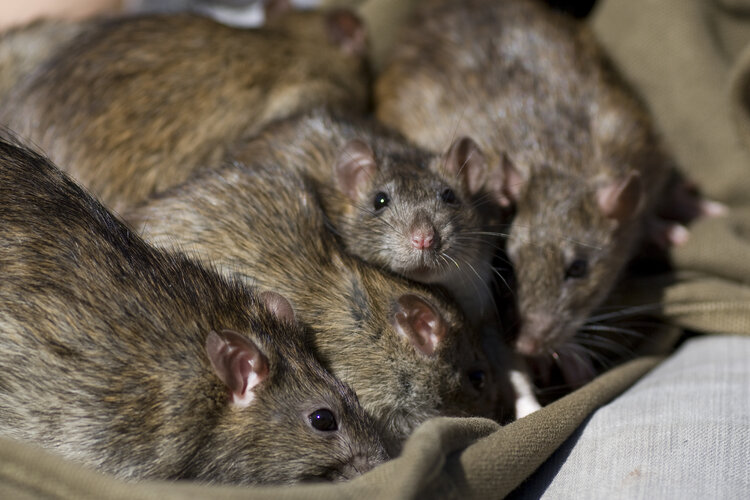Mice and rats are two of the most common and unwelcome guests in our homes and surroundings. While they share many similarities, they also have distinct differences that will influence how you deal with infestations.
Anatomy and Physical Differences
One of the most obvious differences between mice and rats is their size and physical features.
Mice:
- Size: Mice are typically smaller, measuring around 2.5 to 3.75 inches in length and weighing 0.5 to 1 ounce.
- Ears: Mice have large, round ears in proportion to their body size.
- Tail: Their tails are long, thin, and almost as long as their body, covered in fine hair.
- Color: Mice come in various colors, from light brown to gray, and may have a lighter underbelly.
Rats:
- Size: Rats are larger, with lengths ranging from 7 to 10 inches and weighing between 6 to 18 ounces.
- Ears: Rats have smaller ears relative to their body size, which are more rounded and less prominent.
- Tail: Their tails are long, scaly, and mostly hairless.
- Color: Rats often have brown or gray fur, with some species exhibiting a more agouti pattern.
Behavioral Differences
Understanding the behavior of mice and rats can help distinguish between them and address infestations effectively.
Mice:
- Nesting: Mice typically build nests in concealed locations, using soft materials like paper and fabric.
- Diet: They are omnivorous and will consume grains, fruits, vegetables, and even small insects.
- Activity: Mice are curious and agile, often exploring new areas and objects.
Rats:
- Nesting: Rats prefer burrows and nest underground or in secluded, dark areas.
- Diet: They are also omnivorous but tend to favor grains, meat, and protein-rich foods.
- Activity: Rats are cautious and tend to follow established paths, which makes them more predictable in their movements.
Reproduction
Both mice and rats are prolific breeders, but there are differences in their reproductive characteristics.
Mice:
- Reproduction: Mice can reproduce at an astonishing rate, with a single pair capable of producing up to 35-40 offspring in a year.
- Gestation: Their gestation period is approximately 19-21 days.
- Offspring: A typical mouse litter consists of 5-12 pups.
Rats:
- Reproduction: Rats are also prolific breeders but at a slightly slower rate than mice. A pair can produce 20-30 offspring in a year.
- Gestation: The gestation period for rats is around 21-23 days.
- Offspring: A rat litter typically consists of 6-12 pups.
Habitat
Mice and rats have slightly different preferences when it comes to their living environments.
Mice:
- Habitat: Mice are more adaptable to various environments and can be found in homes, fields, and urban areas.
- Nesting: They build nests close to their food source.
Rats:
- Habitat: Rats often prefer more sheltered and concealed locations like basements, sewers, and underground burrows.
- Nesting: They create complex burrows or nests in hidden places.
Signs of Infestation
Recognizing the signs of a rodent infestation is crucial for addressing the issue promptly.
Mice:
- Droppings: Mouse droppings are smaller and have pointed ends.
- Gnawing: Mice leave behind distinct gnaw marks with a smooth, narrow groove.
- Sound: Mice are known for their high-pitched squeaking sounds.
Rats:
- Droppings: Rat droppings are larger and have blunt ends.
- Gnawing: Rats create gnaw marks with a wider, rougher groove.
- Sound: Rats produce a deeper, grating noise compared to mice.
Control and Prevention
Regardless of whether you’re dealing with mice or rats, effective control and prevention measures are essential.
- Seal Entry Points: Identify and seal any openings that rodents could use to enter your home.
- Remove Attractants: Keep food sources, including pet food, in airtight containers, and regularly clean up crumbs and spills.
- Traps and Baits: Use traps or baits designed for the specific type of rodent you’re dealing with.
- Professional Help: If infestations are severe or recurring, consider seeking professional pest control services.
Give Us a Call for Pest Removal
Mice and rats share common traits as rodents, but their size, behavior, and habits distinguish them. Understanding the differences between these two common household pests can help you identify the type of infestation you’re dealing with and take appropriate measures for control and prevention.
Whether it’s a tiny mouse or a larger rat, prompt action is essential to keep your home rodent-free and prevent potential health risks. Call us for help with wildlife removal.


